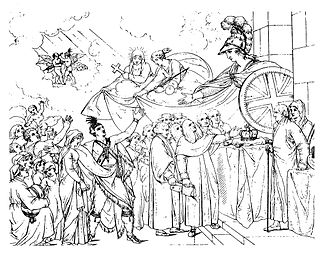Reception of the American Loyalists by Great Britain in the Year 1783 is a lost painting by British–American artist Benjamin West, depicting the return of the American Loyalists to the British Empire following their expulsion from the victorious Thirteen Colonies in the American Revolutionary War. Unlike West's established historical styles, Reception features a highly allegorical composition of European, Black, and Indigenous refugees being welcomed back into the fold by a personified Britannia, who presides over the British Crown Jewels while flanked by angels and government officials surveying the scene.[1]


The original painting and its date of creation have been lost but is survived by a pair of replicas, one by engraver Henry Moses and one by West himself in the background of a later portrait, completed in 1811 and 1812 respectively.[2][3]
Background edit
Britannia had existed as a deification or personification of Great Britain and its people since ancient times, while West's previous work as a painter had developed a deep sense of British nationalism, seen in his Death of General Wolfe and other works painted after his appointment as court painter. West was "not directly involved in the American Revolutionary War, [but] nevertheless had friends, family and colleagues affected by the outcome of the conflict", shaping his view of the Revolution and its fallout.[4]
The American Loyalists, peoples of the Thirteen Colonies who remained loyal to the Crown against the Patriot cause, were commonly noted as transcending racial boundaries. In addition to white colonizers siding with British rule out of conservatism, privilege or reformism, Patriot-owned slaves were officially offered freedom in return for their defection while the Iroquois peoples were polarized between pro-British and pro-French factions. After their defeat in the Revolutionary War, the various anti-Patriot groups were expelled en mass from the newly founded United States, with about 100,000 fleeing primarily to the loyal colonies of what would eventually become Canada, forming many communities both there and abroad that persist to this day. They were there afforded the honorary title of United Empire Loyalist and received land grants handled through the Loyalist Claims Commission, though the Black Loyalist communities would continue to face discrimination for generations to come.
Painting and analysis edit
The figures holding Britannia's train to her right can be identified as Religion and Justice, emphasizing the righteousness of the Loyalist cause, while Britannia herself is shown armed with a Union Jack shield and extending an arm towards the figures below. The Loyalists are depicted as noble and multi-racial, with a group of white lawmakers in full dress pledging themselves to the crown beneath Britannia; Her gesture is instead answered by a central figure of an Indigenous warrior standing alongside a dark-skinned woman and a family of freed black civilians.[4]
The painting is considered historically and culturally significant for its depiction of the Black Loyalists, however historian Barry Cahill instead criticized the painting as presenting what he considered an idealized and inaccurate mythologization of the Black Loyalists' history in Atlantic Canada. He heavily cited the pro-slavery views and practices of many white Loyalists, characterizing the freed Patriot slaves as opportunistic freedom-seekers only trying to survive in what was an inherently oppressive society.[5]
History edit
The timeframe of the painting's creation is extremely uncertain, estimated at anywhere from 1783 to 1811[3] (i.e. anywhere from the actual year depicted through to the publishing of its first replica).
The painting came into the possession of John Eardley Wilmot but was later lost. Its content is nonetheless preserved through a pair of replicas: an engraving by Henry Moses which captures the exact detail and composition of the original, and West's own full-color reinterpretation of the work when he included the original as the background of his later portrait of Wilmot, celebrating Wilmot's capacity as chief commissioner of the Loyalist Claims Commission.[2]
References edit
- ^ Allen, Thomas B. "Who Were the Tories?". Tories: Fighting for the King in America's First Civil War. Archived from the original on 2013-02-21. Retrieved 2013-03-16.
- ^ a b "Black Loyalists in New Brunswick, 1783–1854: John Eardley Wilmot". University of New Brunswick Libraries. Archived from the original on 2014-03-31. Retrieved 2013-11-14.
- ^ a b Norton, Mary Beth. "Eardley-Wilmot, Britannia, and the Loyalists: A Painting by Benjamin West", Perspectives in American History, 6 (1972), pp. 128–31
- ^ a b "Black Loyalists in New Brunswick, 1783–1854: The Reception of the American Loyalists by Great Britain". University of New Brunswick Libraries. Archived from the original on 2014-12-05. Retrieved 2023-04-26.
- ^ Cahill, Barry. "The Black Loyalist Myth in Atlantic Canada." Acadiensis, vol. 29, no. 1, 1999, pp. 76–87. JSTOR 30303264. Accessed 25 Apr. 2023.